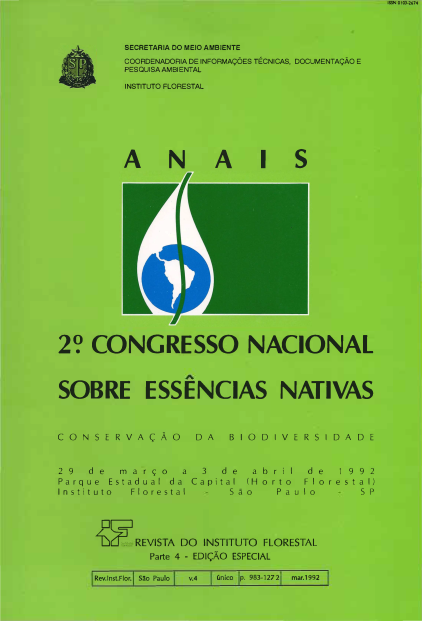DISPERSÃO DE SEMENTES PELO MONO-CARVOEIRO (BRACHYTELES ARACHNOIDES E. GEOFFROY, 1806) NO PARQUE ESTADUAL DE CARLOS BOTELHO
DOI:
https://doi.org/10.24278/2178-5031.199244774Palavras-chave:
Dispersão de sementes, predação de sementes, Brachyteles arachnoidesResumo
Estudou-se as espécies que fizeram parte da alimentação de Brachyteles arachnoides e que se apresentaram viáveis após a passagem pelo trato digestivo dos mesmos. A dispersão de sementes realizada por estes animais indicou uma tendência à diminuição do tempo requerido para a germinação das mesmas, assim como ao escape de predação.
Downloads
Referências
AL TMANN, J., 1974. Observational study of behaviour sampling methods. Behaviour, 49: 227-267.
CANT, J., 1979. Dispersal of Stemmadenia donnell-Smithii by birds and monkeys. Biotropica, 13: 70-76.
DENSLOW, J. S., 1980 .. Gap partitioning among rain foresttropical trees. Biotropica, 12: 47-55.
ESTRADA, A & COATES-ESTRADA, R., 1984. Fruit eating and seed dispersal by howling Monkeys (Alouatta palliata) in the tropical rain forest of Los Tuxtlas, Mexico. American Journal of Primatology, 6: 77-91.
ESTRADA, A. & COATES-ESTRADA, R., 1986. Frugivory by howling monkeys (Alouatta palliata) at Los Tuxtlas, Mexico: dispersal and fate of seeds. In: ESTRADA, A & FLEMING, T. H. (Eds.). Frugivores and Seed Dispersal. Dordrecht, Dr. W. Junk Publishers, 93-104.
FLEMING, T. H., 1979. Do tropical frugivores compete for food? American Zoo/ogists, 19: 1157-1172.
HLADIK,A & HLADIK,C. M., 1969. Rapportstrophiques entre vegetation et primates dans Ia foret de Barro Colorado (Panamá). Terre et Vie, 116: 25-117.
HOWE, H. H., 1980. Monkey dispersal and waste of a neotropical fruit. Eco/ogy, 61 : 944-959-HOWE, H. H. & ESTABROOK, G. F., 1977. On intraspecific competition for avian dispersers in tropical trees. The American Naturalist, 111: 817-832.
HOWE, H. H. & SMALLWOOD, J., 1982. Ecology of seed dispersal. Annual Review of Ecology and "Systematics, 13: 201-218.
JANSON, C. H., 1983. Adaptation of fruit morphology to dispersal agents in a neotropical forest. Science, 219: 187-189.
JANZEN, D. H., 1969. Seed eaters versus seed size, number, toxicity and dispersal. Evolution, 23:1-27.
JANZEN, D. H., 1970. Herbivoresandthenumberoftree species in tropical forests. The American Naturalist, 104: 501-528.
JANZEN, D. H., 1977. Ecologia Vegetal nos Trópicos. São Paulo, E.P.U., EDUSP, 79 p.
JANZEN, D. H., 1983. Dispersal of seeds by vertebrate guts. In: FUTUYMA, D. J. & SLATKIN, M. (Eds.). Coevolution. Sunderland, Massachusetts, Sinauer Association Inc. Publishers, 233-261.
LEIGHTON, M. & LEIGHTON, D. R., 1982. The relationships of size of feeding aggregate to size of food patch: howler monkeys (Alouatta palliata) feeding in Trichilia cipo fruit trees on Barro Colorado Island. Biotropica, 14: 81-90.
LEIGHTON, M. & LEIGHTON, D. R., 1983. Vertebrate responses tofruiting seasonalitywithin a bornean rain forest. In: SUTION, S. L., WHITMORE, T. C. & CHADWICK, A C. (Eds.). Tropical Rain Forest: eco/ogy and management. Oxford, Blackwell Scientific Publications, 181-196.
LIEBERMAN, D. et alii., 1979. Seed dispersal by baboons in Shai Hills, Ghana. Ecology, 60: 65-75
MCKEY, D., 1975. The ecology of coevolved seed dispersal systems. In: GILBERT, L. E. & RAVEN, P. H. (Eds.). Coevolution of AnimaIs and Plants. Austin, University of Texas Press, 159-191.
MILTON, K., 1984. Habitat, diet and activity patterns of freeranging woolly spider monkeys (Brachyteles
arachnoides E. Geoffroy 1806)./nternational Journal of Primato/ogy, 5 (5): 491-14.
MITIERMEIER, R. A & ROOSMALEN, M. G. M., van. 1981. Preliminary observations on habitat utilization and dietin eight Surinam monkeys. Folia Primato/ogica, 36:1-39.
MUSKIN,A &FISCHGRUND,AJ., 1981.Seeddispersal of Stemmadenia (Apocynaceae) and sexually dimorphic feeding strategies by AteIes in Tikal, Guatemala. Biotropica, 13: 78-80.
PIANKA, E., 1982. Ecologia Evolutiva. Barcelona, Editora Omega, 137-288.
ROOSMALEN, M.G. M., van., 1985. Habitatpreferences, diet, feeding strategy and social organization of the black spider monkey (AteIes paniscus paniscus LINNAEUS 1758) in Surinam.Acta Amazonica, 15(3/4): 1-238.
STRIER, K. B., 1986. The behavior and ecology of the wool/y spider monkey or muriqui (Brachyteles arachnoides E. Geoffroy 1806). Cambridge, Unpublished Doctoral Dissertation: Harvard University, 352 p.
STRIER, K. B., 1987. Ranging behaviorofwoollyspider monkeys, or muriquis, Brachyteles arachnoides. International Journal of Primato/ogy, 8 (6): 575-591.
STRIER, K. B., 1989. Effects of patch size on feeding associations in muriquis (Brachyteles arachnoides). Folia Primatologica, 52 (1/2): 70-77.
TERBORGH, J., 1986. Keystone plant resources in the tropical forest. In: SOULÉ, M. E. (Ed.). Conservation Biology 2. Sunderland, Massachusetts, Sinauer Association Inc. Publishers, 330-344.
VELOSO, H. P. & GOES-FILHO, L., 1982. Fitogeografia brasileira, classificacão fisionômico-ecológica da vegetação neotropical. Boletim Técnico. Projeto RADAMBRASIL. Sér. Vegetação, Salvador, 1: 1-80.















